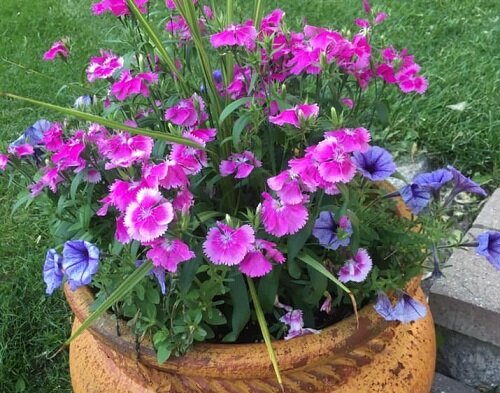how to overwinter perennials in containers
Many of the same methods used for protecting roses, shrubs and evergreens in containers can be used to protect perennials in containers over winter.
Why Container Perennials Need Protection in Colder Regions
In colder regions, nearly every perennial growing in a container will need some sort of protection if you expect it to survive winter. Growing every imaginable plant in mixed container gardens is getting more and more common, and many gardeners have become very creative with protection methods.
If you want to try and let your perennials struggle through winter in a container without help, be sure to choose plants that are at least 2 zones hardier than your growing zone.
The soil in a container is very exposed to winter cold and will not only freeze quickly and thoroughly but will also go through many freeze-and-thaw cycles. This may have the soil mass up and may also damage roots.
Steps for Protecting Container Perennials During Winter
There are a few steps that should be taken to help your plants get through winter in a container, no matter how hardy the plants are:
When the plant stops actively growing, do NOT fertilize any longer.
Continue watering as necessary until the soil freezes.
If your plants are extra hardy, occasional light watering can be helpful throughout the winter even though it is not growing. But never over water, the soil should not be wet, just slightly moist. Too dry is much better than too wet.
Options for Overwintering Container Perennials
If your plants are not quite hardy enough to survive winter without protection:
Bury the whole pot in your vegetable garden, as though you were planting it pot and all. The surrounding soil will protect perennials that are hardy to your zone just like the ones you have planted in the ground. Mulch it like you would any perennial.
Re-plant the perennials in the ground. Then just dig them up in early spring and return to the container.
Store the container in an unheated garage. Do so well after a hard freeze if it is a freeze hardy perennial and take it outside again as the overnight temperatures are around freezing. Adjust the timing according to how hardy your plants are. You may need to give the pots a light sprinkling if the soil gets bone dry.
The best soil temperature for storing most perennials is about 30 to 35 degrees Fahrenheit. Depending on your region, a storage or potting shed may keep your pots warm enough. In very cold regions you may need to store the container along the wall adjoining the heated house to keep it warm enough. When storing in a garage you should also cover your perennials with a blanket to protect from cold air blasts when you open the garage door.
Storing Container Perennials in an Attached Garage
If you store potted perennials in an attached garage, warm spells in early and late winter can encourage you perennials to try and grow before they should.
I forgot about some tulip bulbs in a container one year by March they had produced long white stems trying to find sun in a dark garage.
Just a few days above freezing can warm up your garage substantially. So wait to store them until long after a hard freeze and put them back outside well before the first big spring thaw.
They will remain dormant until the soil warms up. Keep the pot covered to keep moisture out of the soil if the container is susceptible to cracking.
Tips for Overwintering Marginal or Tender Container Perennials
If you are trying to overwinter perennials that are considered marginally hardy in your region or not hardy at all, take some tips from gardeners who grow tender roses.
They have some very creative ideas for overwintering tender potted roses that will work just as well for your prized or special tender perennials.
Many of their methods are detailed on the Winter Protect Container Roses page. These methods will work just as well for tender perennials as potted rose standards.
Conclusion
Whatever method you choose, or create for yourself, just keep an eye on the soil temperature and your perennials will do just fine.
